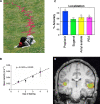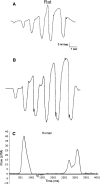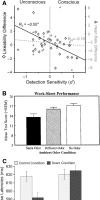Human olfaction: a constant state of change-blindness
- PMID: 20603708
- PMCID: PMC2908748
- DOI: 10.1007/s00221-010-2348-6
Human olfaction: a constant state of change-blindness
Abstract
Paradoxically, although humans have a superb sense of smell, they don't trust their nose. Furthermore, although human odorant detection thresholds are very low, only unusually high odorant concentrations spontaneously shift our attention to olfaction. Here we suggest that this lack of olfactory awareness reflects the nature of olfactory attention that is shaped by the spatial and temporal envelopes of olfaction. Regarding the spatial envelope, selective attention is allocated in space. Humans direct an attentional spotlight within spatial coordinates in both vision and audition. Human olfactory spatial abilities are minimal. Thus, with no olfactory space, there is no arena for olfactory selective attention. Regarding the temporal envelope, whereas vision and audition consist of nearly continuous input, olfactory input is discreet, made of sniffs widely separated in time. If similar temporal breaks are artificially introduced to vision and audition, they induce "change blindness", a loss of attentional capture that results in a lack of awareness to change. Whereas "change blindness" is an aberration of vision and audition, the long inter-sniff-interval renders "change anosmia" the norm in human olfaction. Therefore, attentional capture in olfaction is minimal, as is human olfactory awareness. All this, however, does not diminish the role of olfaction through sub-attentive mechanisms allowing subliminal smells a profound influence on human behavior and perception.
Figures






Similar articles
-
All in a sniff: olfaction as a model for active sensing.Neuron. 2011 Sep 22;71(6):962-73. doi: 10.1016/j.neuron.2011.08.030. Epub 2011 Sep 21. Neuron. 2011. PMID: 21943596 Free PMC article. Review.
-
The sniff is part of the olfactory percept.Chem Senses. 2006 Feb;31(2):181-96. doi: 10.1093/chemse/bjj012. Epub 2005 Dec 8. Chem Senses. 2006. PMID: 16339268 Review.
-
The perception of odor is not a surrogate marker for chemical exposure: a review of factors influencing human odor perception.Clin Toxicol (Phila). 2013 Feb;51(2):70-6. doi: 10.3109/15563650.2013.767908. Clin Toxicol (Phila). 2013. PMID: 23387344 Review.
-
"What Smell?" Temporarily Loading Visual Attention Induces a Prolonged Loss of Olfactory Awareness.Psychol Sci. 2018 Oct;29(10):1642-1652. doi: 10.1177/0956797618781325. Epub 2018 Aug 1. Psychol Sci. 2018. PMID: 30067445
-
Peripheral adaptive filtering in human olfaction? Three studies on prevalence and effects of olfactory training in specific anosmia in more than 1600 participants.Cortex. 2015 Dec;73:180-7. doi: 10.1016/j.cortex.2015.08.018. Epub 2015 Sep 12. Cortex. 2015. PMID: 26457822
Cited by
-
Rapid stress system drives chemical transfer of fear from sender to receiver.PLoS One. 2015 Feb 27;10(2):e0118211. doi: 10.1371/journal.pone.0118211. eCollection 2015. PLoS One. 2015. PMID: 25723720 Free PMC article.
-
Quality-space theory in olfaction.Front Psychol. 2014 Jan 16;5:1. doi: 10.3389/fpsyg.2014.00001. eCollection 2014. Front Psychol. 2014. PMID: 24474945 Free PMC article.
-
Anticipation-induced delta phase reset improves human olfactory perception.PLoS Biol. 2020 May 26;18(5):e3000724. doi: 10.1371/journal.pbio.3000724. eCollection 2020 May. PLoS Biol. 2020. PMID: 32453719 Free PMC article.
-
The smell of death: evidence that putrescine elicits threat management mechanisms.Front Psychol. 2015 Aug 28;6:1274. doi: 10.3389/fpsyg.2015.01274. eCollection 2015. Front Psychol. 2015. PMID: 26379597 Free PMC article.
-
Salivary Proteome Changes in Response to Acute Psychological Stress Due to an Oral Exam Simulation in University Students: Effect of an Olfactory Stimulus.Int J Mol Sci. 2021 Apr 21;22(9):4295. doi: 10.3390/ijms22094295. Int J Mol Sci. 2021. PMID: 33919012 Free PMC article.
References
-
- Abrams RA, Christ SE. Motion onset captures attention. Psychol Sci. 2003;14:427–432. - PubMed
-
- Ache BW, Young JM. Olfaction: diverse species, conserved principles. Neuron. 2005;48:417–430. - PubMed
-
- Ackerl K, Atzmueller M, Grammer K. The scent of fear. Neuro Endocrinol Lett. 2002;23:79–84. - PubMed
-
- AMA . Guides to the evaluation of permanent impairment. Chicago: American Medical Association; 1993.
Publication types
MeSH terms
LinkOut - more resources
Full Text Sources
Other Literature Sources

